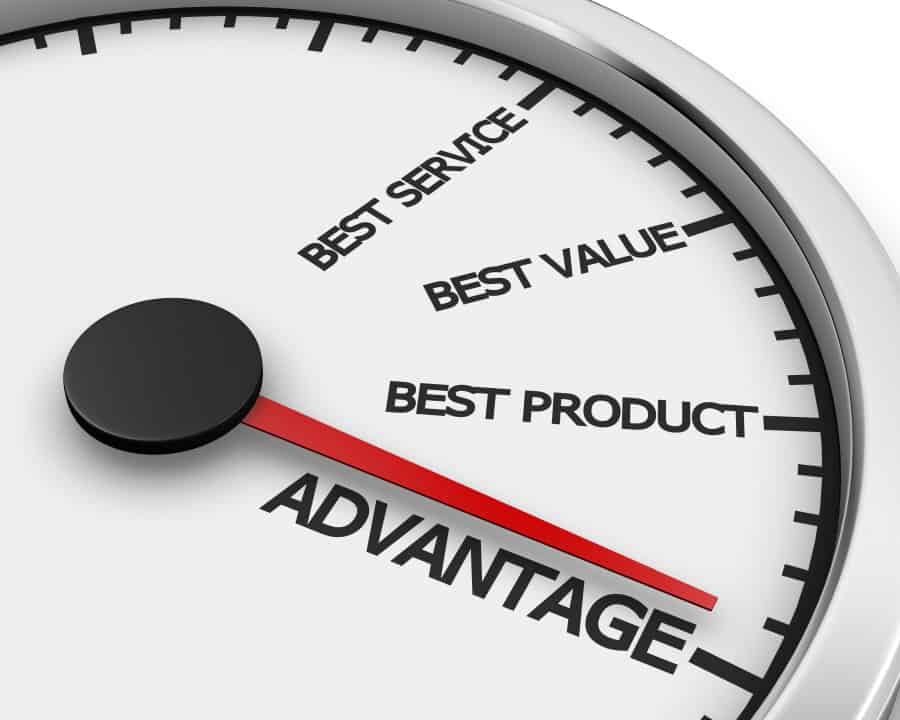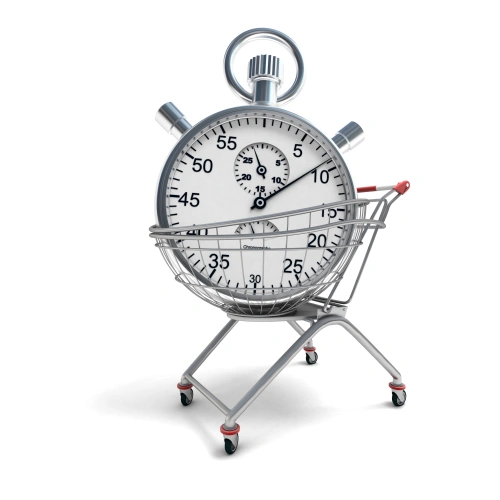17 Differentiation Strategies for Competitive Advantage
Differentiation strategies to get you ahead
In this article you will find out about about differentiation strategies that you can use to improve authenticity of your products, and ultimiately – set yourself ahead of your competition.
What are the differentiation strategies?
Your company may be in a competitive market. There may be many companies like yours, which are likely to have plenty of similar products or services. On the one hand, your customers have their wishes, wants and needs, on another – you have your company with your products and services. You may be thinking – how can I get through all the distractions that my customers may have, and become a top product on their mind when they are thinking about a specific need that your products fulfill.
To be able to stand out from the competition, your product or service needs to have at least some distinctive features that will look attractive to a prospective customer. At best, your product needs to be authentic and unique to make the competition irrelevant. Such products have a much higher chance of being noticed by your customers.
Differentiation strategies help you to set your business apart from the competition. The more authentic and unique your products are, the higher are the chances that your customers notice them.
Differentiation strategies help you to select and implement specific ways of how your business, product, or service will be different from the competition.

What is a competitive advantage?
When your products are authentic, they will have a higher chance of success with your customers. The more customers notice your products, the more sales you will achieve. Sales will lead to your company’s prosperity, and with time – will help you get ahead of the competition.
This is precisely what the competitive advantage is – being able to get ahead of the competition.
To achieve a competitive advantage, you need to have all the right ingredients in place. These include:
- Practical and achievable business strategy.
- Products that solve the pains of your customers.
- A sustainable way to manufacture or source your products.
- Effective sales and marketing practices that will help to connect your customers with your products.
These ingredients ensure that you can deliver on your promise to your customers. By themselves, these ingredients do not establish the link between what is on the mind of your customer, and their decision to buy from your company.
Competitive Advantage Example
To achieve that, we need to look at the entire spectrum of their very specific need. For example, if someone is hungry, there is a wide range of choices ranging from high-end restaurants to authentic restaurants from many cultures. On the other side of the spectrum, you have faster foods, such as takeouts, deliveries, and fast-food restaurants. The choice could seem overwhelming, yet the need to eat is straightforward.
Our hungry friend may choose to eat an authentic, healthy salad, and an ABC Healthy Salad Company may immediately jump to their mind. How exactly did it happen? An ABC Health Salad Company made a specific choice to differentiate itself and focus on the healthy salads segment of the food market.
For ABC, it happened because they chose to focus on a specific segment of the market and differentiate themselves from the rest of the competition. Differentiation strategies that they have implemented led to our hungry friend noticing them, and buying from them, and ultimately, many customers later, to a competitive advantage in the healthy eating space.
Without a competitive advantage, your company may be left behind.
Differentiation Strategies to Achieve Competitive Advantage
Let’s now look at what kind of differentiation strategies you can use to become more authentic, more competitive, and ultimately – get ahead of your competitors, and achieve competitive advantage.

1. Selective Approach
The first differentiation strategy – is to have a selective approach. Rather than focusing on all aspects of pain that your customer is experiencing, you can choose just one pain of your target customer segment that you are really good at alleviating or addressing.
And after that, you can show how you are addressing it, and highlight that you are much better at it than your competition.
You can emphasize specific features, characteristics, or components of your product. You can also show how effective is your surgically sharp focus in addressing specific pains that your customers are facing.
Do not forget to publish case studies of your past customers, their testimonials, and success stories that describe how effective you were in addressing their pain points.
2. Progressive Improvement
Another differentiation strategy is if you are offering the same product or service that others do, you can be much better than your competitors in gathering your customers’ feedback and enhancing or tailoring your product or service based on the feedback received.
For example, if you own a boutique pizza shop, the chances are that there may be few other pizza shops on your street. Have you been making a few of the same pizza recipes all along, or have you implemented a consistent way to ask your customers for their feedback?
Have you considered the right incentive for the customers to provide their feedback, for example – an extra topping or a free dip that will cost you very little in the context of the value you will get from your customers’ insights?
If this model doesn’t work for you, how about a giveaway? What may your customers want to win in exchange for the most insightful idea or feedback that could help your company improve?
3. Pricing Differentiation Strategies
There are several pricing differentiation strategies that you can consider. The most obvious strategy is price leadership, which is offering lower prices, and competing based on price leadership.
Give it a thought – would it be possible for you to slightly reduce your product’s price to make it more competitive and make up in volume what you may have lost based on price?
Another approach to product pricing is to offer premium features of the product. Think Lexus (as compared to Toyota), we perceive this brand as being premium, even though the same company is making both the premium product (Lexus) and the mainstream version (Toyota). With the premium product, you can emphasize luxury, premium features, exclusivity, and other advantages of owning your product.
There is also a “blue ocean” strategy which establishes a new market segment “in between” cost leadership, and premium features. Such a market segment will have some premium features, perhaps ones that are most required by the customers for a fraction of the premium product’s cost.
Yet another pricing differentiation strategy is to offer tiered pricing. For example, your products may be priced as follows:
Barebones product: $100
Barebones product with some additional features: $300
Ultra-premium product package: $900
The key is to have a significant jump from the midsize product to ultra-premium. Do you see the jump of $200 between the barebones package, and $600 to the ultra-premium? This is it!
When you have this kind of tiered pricing structure that you show side by side, you can cover different segments of your customers who may require different features of your product, and at the same time – reduce price-related objections. If you had priced your product at $100, a few of your customers would have had objections, or hesitation to spend $100. When they see that the premium version of the same product, with some bells and whistles, costs $900, suddenly the price of the base product looks like a steal.
You may also offer convenient payment terms, or pay as you go options with the ability to cancel at any time. These are also excellent types of pricing differentiation strategies.
4. Product or Service Composition
Your product may become even more distinctive and different based on what goes into your product or service. For example, if you are consulting your clients, you may offer them better research than your competition.
You may also give your customers a better choice. For example, if you are in consulting, and your competition typically comes up with the 3 implementation options and 1 recommendation, you may come up with 5 options, and emphasize that you offer a more comprehensive approach.
Such extra mile will give your client a better understanding of their current state, and the roads that will lead to improvement. You will show your customer more optimal paths about how they can get to where they would want.
You may also want to examine your product’s composition and its features and include some features that may cost you next to nothing while being incredibly important to your customers.
5. Product Distinctiveness
What exactly makes you different from your competition? Does your product have authentic or distinct features, or merely a different packaging or a style of packaging? When looking at your product on the shelf or online, will your customers know right away that the product comes from your company?
For example, if you sell coffee, you may offer it in black bags with bright shapes of objects, such as flowers, animals, places, or landscapes that would differentiate one kind of coffee from another.
6. Product Branding
Yet another differentiation strategy – is with product branding. What kind of branding do you use for your products? How about colors and fonts?
Are you using a very distinctive and unmistakable combination, for example – like Telus – white background and colored pictures of animals?
Are you using very specific images, with consistent post-processing, for example – adding a blue tint to make them appear more distinct?
Does your stationery, or swag (which is your company merchandise given to its clients) have different shapes? Does it come in unique shapes, or perhaps unique colors, such as neon or pastel?
7. Taking Riskier Choices
Your company can also get ahead by taking riskier, less common, or non-mainstream choices or approaches. Don’t just play it safe, and do what everyone else does in your field.
Typically, if your customers have a problem, there is more than one road that leads to the resolution of that problem. Some roads may be shorter; others could be longer. Some roads may be much riskier; others may be nearly risk-free.
If, for example, you are providing services to a financial services industry – the status quo of all the players (both the solution providers and financial service institutions) may be in the risk-averse territory. However, if your client is smaller and has more aggressive growth plans – they may be willing to take riskier choices.
Formulating a product offering highlights if the product can get your customers to their destination faster, perhaps with slightly higher risk exposure.
If you are providing a service, in your option analysis, at least give your customers an option to take the shorter path, and at the same time – show how you will help them along the way to complete that path with the lowest possible consequences.
8. Disrupt the Pattern
You may have a common way in your industry how all competitors are approaching business development, addressing customer problems, or positioning their value proposition. Can you disrupt that, and do something differently?
For example, you may be an investment advisor, and you may feel confident about your abilities to make money in any market condition.
The pattern in your industry may be to meet the client, speak with them for a while about the market, types of investments, levels of risk, and many other factors.
This may be one reason why quite many of the customers are turned off when someone is mentioning that they are a financial advisor. A client could be thinking about the pain of sitting through the meeting, listening to all of that, not as useful information, while all they care for is to see that their money is multiplying.
Under such circumstances, do something differently. For example, tell them that you can take $50 of their money, add to that $50 of your funds, and invest this mini-portfolio over the next few weeks. And after that, you will show them specific results, and even let them keep your contribution if they sign up for your service.
Which other patterns exist in your industry or how your customers are accomplishing what they need in their business or personal lives? Can you approach it from a clean slate, and accomplish things more innovatively, leaving your competition far behind?
9. Buy-in Based on Customers Relating to Who You Are, Your Values, or Your Mission
Your customers may believe in the same thing that you do, and they may have the same values.
Under values – I mean the moral framework of how they see the world, more specifically – what is crucial for them about their choices.
For example, it may be necessary for your client to help or support lower-income families, newcomers, homeless, or any health-related causes. Much the same way, your clients may desire to reduce environmental impacts or have any other values.
Much the same way, your customers may have significant respect for the school that they went to. For example, if you are just starting and see a client who went to the same school as you did – your client may be more inclined to do business with you to support their fellow alumni, even if your competitor may be slightly ahead of you.
Another product differentiation example – a professional services company may mention that they spend 10% of their revenues supporting the homeless and lower-income families.
You may also emphasize that you use environmentally-friendly packaging for your products and the extra mile that your company goes to ensure that your products are organic, ethically sourced, or created without harmful chemicals. This will likely resonate with many potential customers who are conscious about the environment and their health.
10. Quality
For some clients, quality may be a deciding factor in their product purchasing decision. With them, your differentiation strategy could be based on the quality of your product. Alternately, you may also highlight the quality or maturity of your processes, as those will translate into product quality.
That is why some companies are obtaining ISO certification and mentioning that they are ISO certified. For some industries, such as auto parts, specific quality targets are an absolute must. For other industries, such as food distribution, ISO certification may not have as high value in practice but may be perceived by their clients as necessary.
You do not have to go as far as to differentiate your product based on its quality. You can simply highlight a few extra things or an extra mile that your company is making to ensure that your products or services meet or exceed quality targets and quality expectations.
11. Ease of Transaction
You can achieve further differentiation by making the transaction with your customer easier.
Things like unconditional satisfaction guarantee, 30 day no-questions-asked return policy, or Costco-style return policy of 90 days will make the transaction a no-brainer.
Your customers do not want to be “sold” to. They don’t want to be left helpless with the product or service that doesn’t meet their expectations, yet with which they are stuck, and can do nothing.
Quite a few of the customers who purchased $10 item that they no longer need, may spend an hour or two returning it. They may need to drive to a store that is not that close to them, spend some time in the store, speak, or even argue with the manager as the sales staff may not want to accept the return, and driving back to their residence or an office, perhaps spending some time in traffic.
When they want to return an item, they are clearly driven by other factors, not just the recovery of the purchase price. If we look for the transaction on the basis of price, for an hour or couple of hours, they would have spent at least $100 worth of their time. Yet, the amount of the refund would be 1/10th of that cost.
What will be driving your customer towards such a behavior? For example, a customer may think that by refunding an utterly useless item, they make their voice heard. They may also be thinking that they are taking a vote with their wallet of not supporting a company that may create inferior quality products. For some, this may be worth an hour of their time.
If customers are not satisfied with the transaction’s specifics, they may also go the extra mile to punish the company intentionally. They can accomplish this by leaving bad reviews or creating a complaint.
That is why it is crucial to make the transaction easier, almost to being a no-brainer to acquire your product. And most importantly, avoid your customers feeling trapped with the item they don’t need or can’t use.
12. Extended Warranty
Extended warranty, more favorable warranty terms, or even a lifetime warranty, may be other exceptional ways to differentiate your product. Combined with the Ease of Transaction, both differentiation strategies offer customers more peace of mind while acquiring your products.
If something got broken with your product, even if due to the customer’s fault, you may want to send the replacement to them at no extra cost.
Why would you want to do so? With the ever-increasing competition, it is important to look at the cost aspect. How much did it cost you to acquire your customer and nurture the relationship with them to the current level?
Will their mishap (that may have happened due to their fault) with the tiny widget of your product that costs you next to nothing, in fact, cost the entire relationship with that client? Very likely!
Will the client satisfaction increase, nearly exponentially, likely leading to even more purchases, if they receive a replacement of what they have broken while knowing that it was their fault? Almost definitely!
13. Clearly Showing the Benefits
When you show the benefits of your product, it is very important to highlight how its features and characteristics will help address the pain that your customer is experiencing. It is also important to describe the pain using the language that your customer is using.
Many of the companies, even some of your competitors, don’t do a great job highlighting benefits. Sometimes, features of the product are not linked to the pain of the customer that hurts. At other times, there is an emphasis on assuming that customers buy based on their needs rather than their wants. There are many other pitfalls, too, of how my former coaching clients describe the benefits of their products and services.
Take a look at how good of a job your competitors are doing when showing benefits. Can you do a better job? How about much better?
14. Reward Your Customers
If you already have a customer base, reward them for being your customer! You may differentiate on how exactly you are doing it.
Treat your customers royally. By selecting your product, they have given their vote of confidence to your company. And to get that vote from a new customer, and sell to them, will likely be 10 times more difficult than selling to an existing customer, who may already be a vocal advocate of your brand.
Give your customers something to reward them for their loyalty. One of the mainstream ways – are the points that they can accumulate. The more your customers buy, the more points they collect.
You may also want to explore some of the more unique ways of rewarding your customers, such as having a sale of your products that is open only to your existing customers or offering your partner company’s products or services at a discounted price. Likely, your partner will not have objections if quite a few of your customers will acquire their products at a discount.
What else are you doing to reward your customers and prevent them from even thinking about dropping your products, and breaking the product-based relationship with your company?
Are you taking such measures incrementally and strategically? Are these measures resulting in your customers becoming the most reliable and most vocal advocates of your brand, who will passionately argue for their friends and colleagues’ benefits?
15. Leverage Exclusivity
Give your existing or new customers an ability to feel somehow special.
For example, you may offer your existing customers an ability to preview a new product that you are launching as a thank you for their loyalty. You may also wish to emphasize that such an offer is not available to anyone, but they have deep and sincere gratitude for their loyalty.
What kind of unique or interest-based club can you create? Even if you create an email address or a group with the word “VIP,” they will still feel very special.
How can you provide to your customers something that will not be available to them otherwise? Can you offer them a library of solutions, publications, or case studies? Can you offer them some other products that you may be selling at a steep discount? Can you foster and support interactions, collaboration, or networking among your customers that will help them to learn from each other’s mistakes (at the very least – with your product), and as a result – will they have additional benefits?
Customers are paying large sums of money to feel special and exclusive. How can you leverage that in your business?
16. Differentiation Based on Specific Core Competencies
Core competency is what you are really great at. It may be another one of differentiation strategies that you can use.
By virtue of your experience, background, and how you have set up your product or service, what kind of differentiation can you achieve? For example, your company may have spent an extra effort to achieve a faster time to market. As a result of focused measures, you may have achieved incredibly fast turnaround time from the product idea and product composition to product implementation and launch.
If that is, in fact, the case, then you can position your product or service as the link that will take the least amount of time between the present-day realities and pains that they experience, and the target state, when they are happily using your product, and reaping its sizeable benefits.
Do you have really fast customer support, where with the help of technology and outsourcing across several time zones, you have an ability to offer support 24×7?
What are the other competencies that you have? Perhaps, you may take another look at some of the competencies that you may be taking for granted.
17. Offer Your Product or Service In Increments
You do not have to offer your product or service in its entirety. You may want to split it into parts, offer different licensing models, product increments, or the same product with different tiers, or increments of product features.
For example, let’s look at the product differentiation strategy of DropBox (cloud storage provider), and several factors that led to their explosive growth:
- First, Dropbox offered a free tier of service of several gigabytes of free storage.
- Dropbox meticulously highlighted the service benefits – encouraging users to invite their friends, family, acquaintances, and colleges to use their service.
- They have rewarded both the person who extended the invitation, and those invited with the same increment of storage space added for free.
Could something like this apply to your industry and your product or service? Can you offer samples, free trial without a credit card, or in fact, anything to get your customers to see what an experience of using your product or service will feel like?
Bonus Idea: Leverage Differentiation Strategies From Another Industry
To further differentiate your products or services, take a look at what leading companies in another industry are doing. They do not have to be in the same industry as you are, in fact, some of the more incredible ways to differentiate may come based on differentiation strategies that have been proven to work very well in other industries.
How to Implement Differentiation Strategies
While you may be tempted to use all of these differentiation strategies, a much better way would be to select several strategies that make sense in your objectives, a product, or a service that you have. You also need to measure the effectiveness of the changes that you are introducing and ensure that they bring the desired results.
Take Action!
Start Improving Your Business Today!
Conclusion
You have learned about 17 differentiation strategies that you can use to achieve a competitive advantage. See which ones of them are more applicable to your business model, and your products.
Are you tempted to use all of these strategies at once? You might be.
A much better way will be at first to measure what you want to improve. After that, select one or two differentiation strategies and carefully implement them.
Also, be sure to avoid the common pitfalls, for example – make sure not to alienate your existing customers with additional product features.
Do you have a differentiation strategy to share? Have you achieved success with one of the differentiation strategies above? Please leave a comment – I’d love to hear from you!
About the Author

Eugen Spivak is a multi-award-winning author, business strategist, and a business coach. Eugen is the founder of the Canadian Institute of International Business, an organization dedicated to bringing practical and hands-on business education for modern business leaders.


